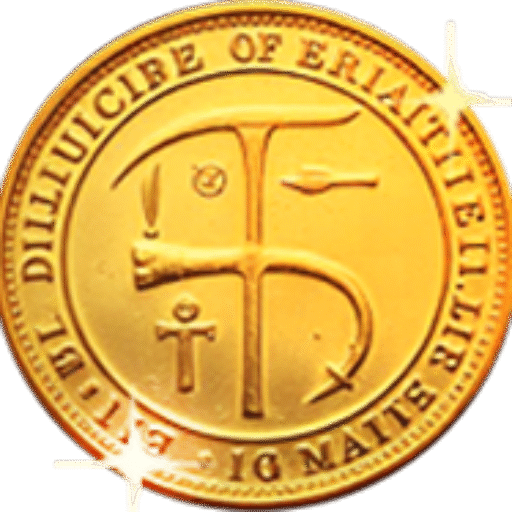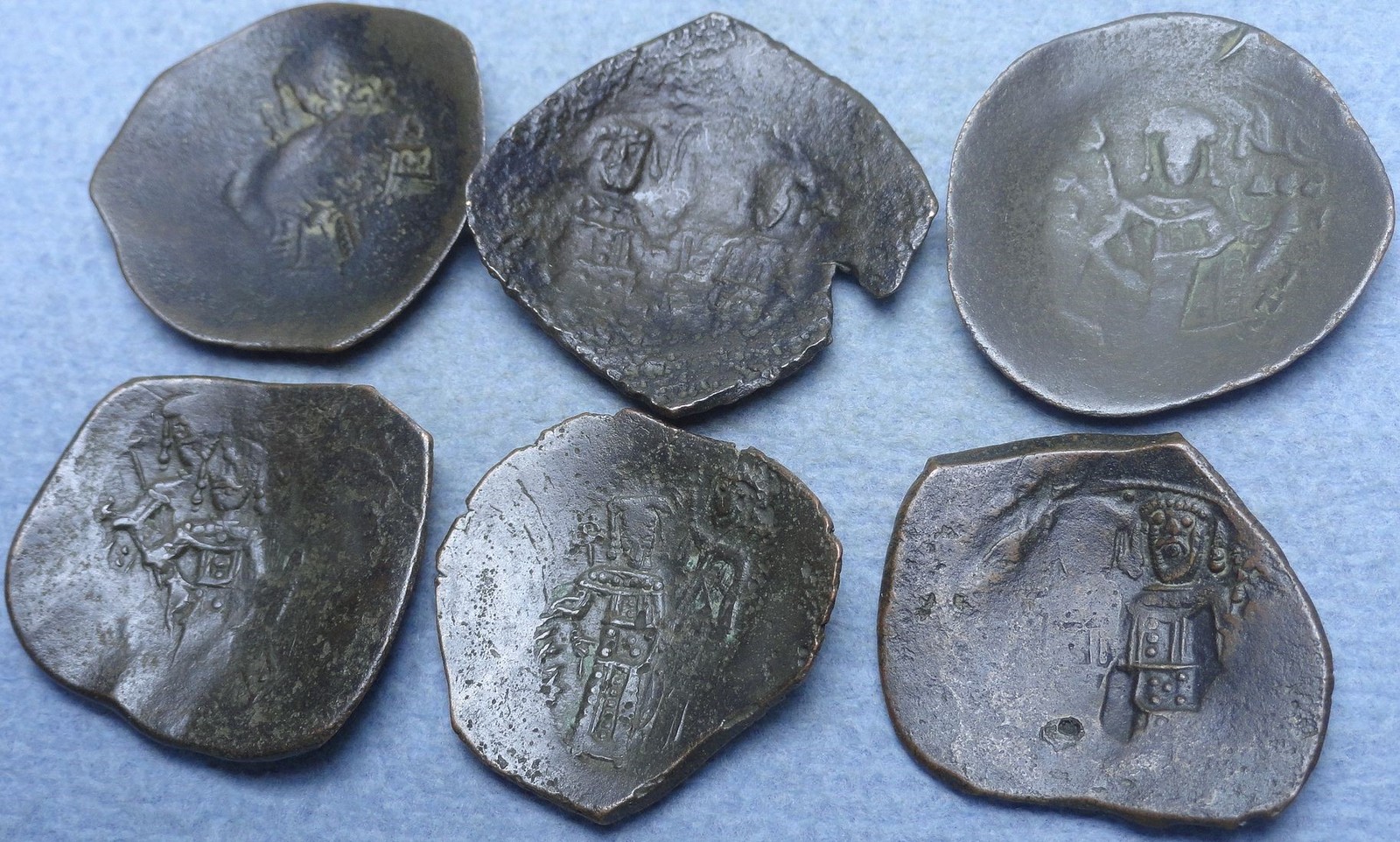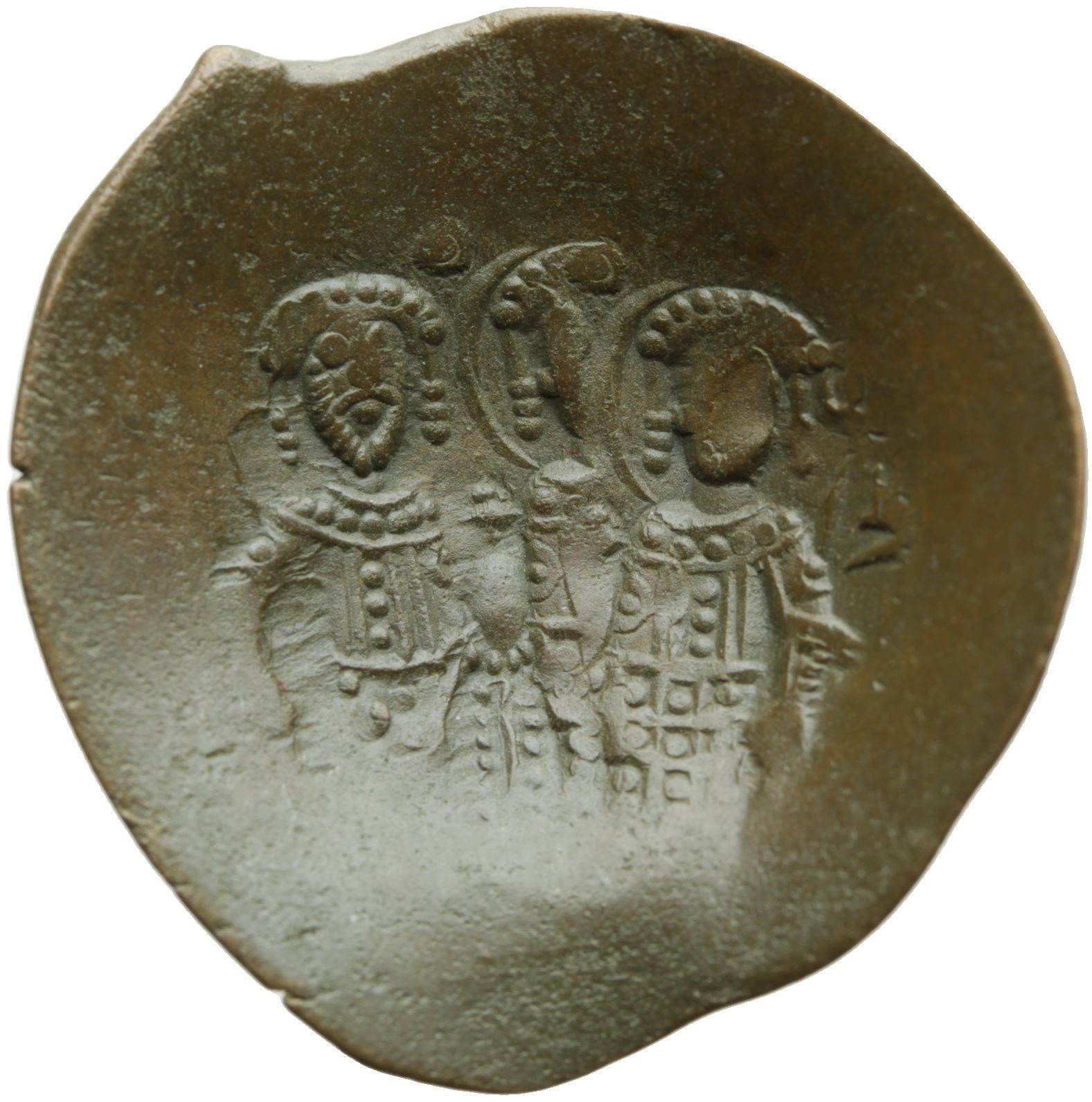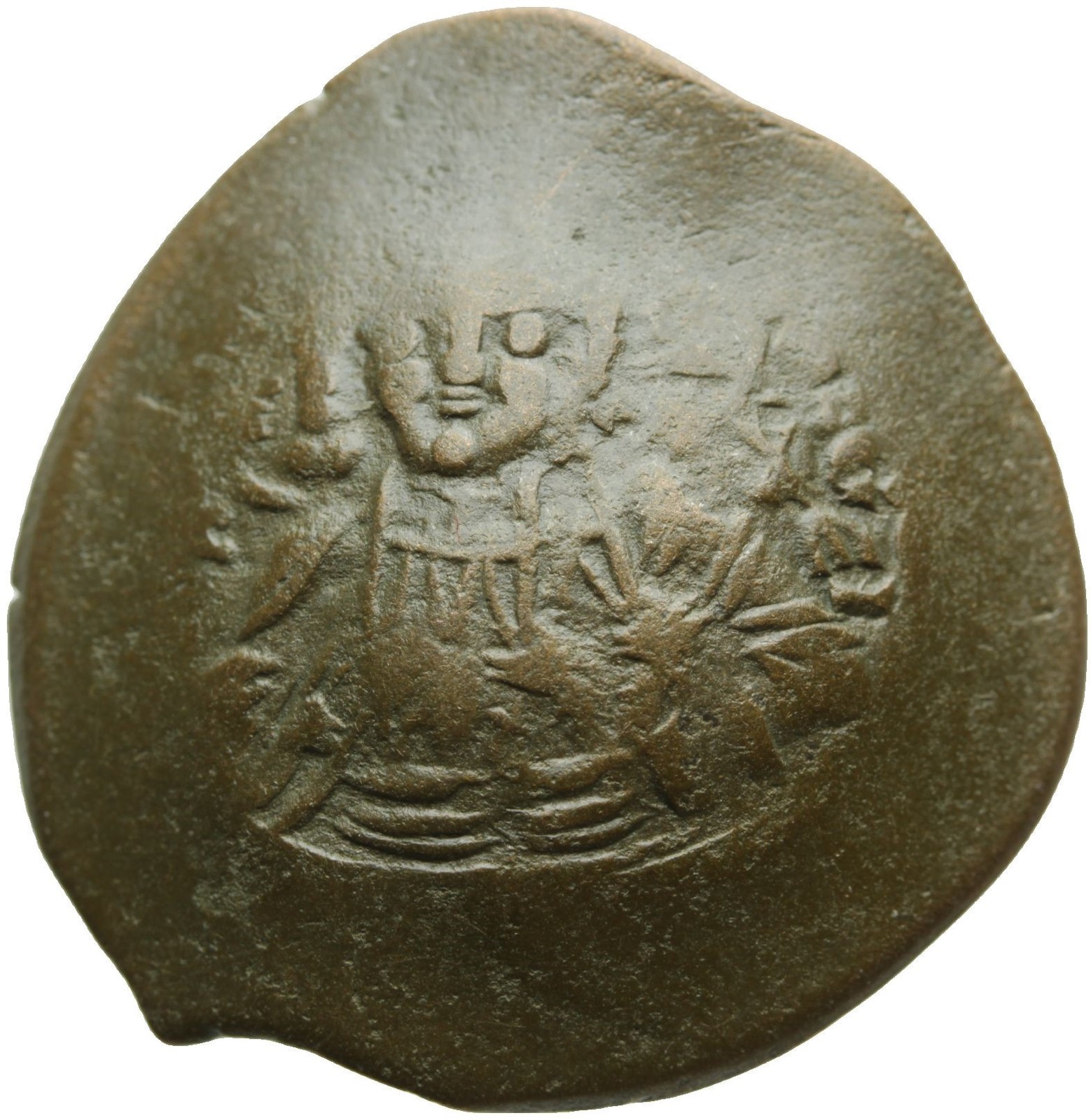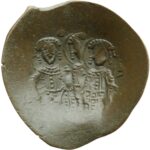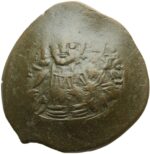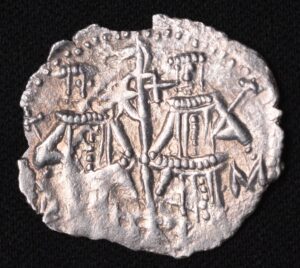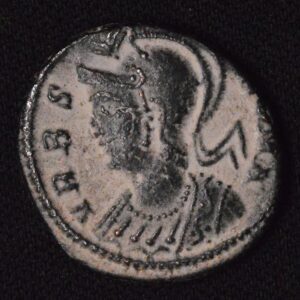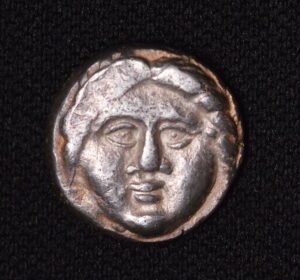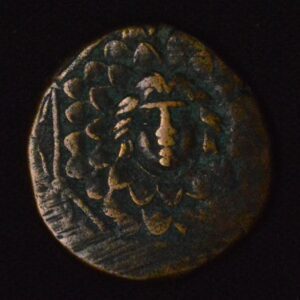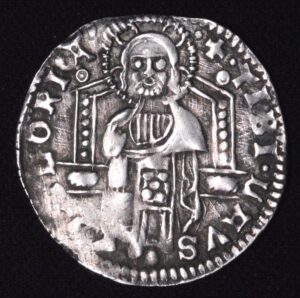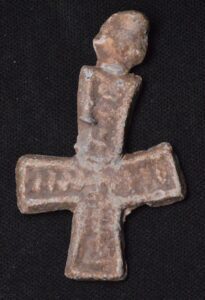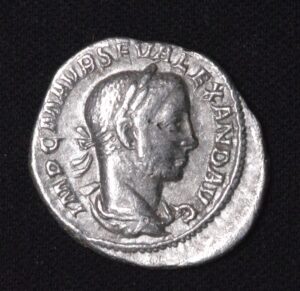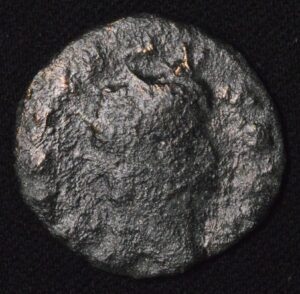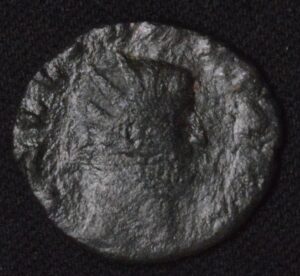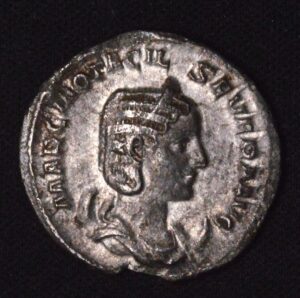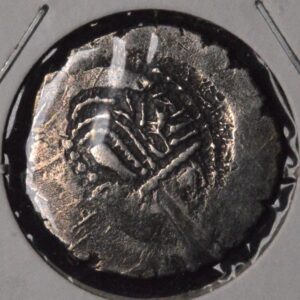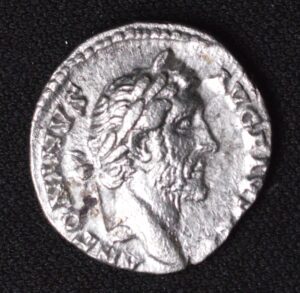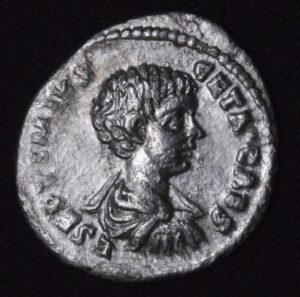Description
Byzantine bronze cup coins, often called “trachy” or “trachea” (plural), are distinctive concave or cup-shaped coins minted during the late Byzantine Empire, roughly from the 11th to 14th centuries (circa 1000–1300 AD). These coins were typically made of billon, an alloy of copper and silver, sometimes with traces of silver wash, which gave them a unique metallic character. The concave shape served a practical purpose: as the purity of the silver decreased over time and coins became thinner and more brittle, the cup shape improved the structural strength of these delicate pieces, reducing bending and breakage.
The obverse side of these coins often depicted religious iconography such as Christ Pantokrator (Christ the Almighty) or the Virgin Mary, rendered in a stylized Byzantine artistic fashion, often showing Christ enthroned or the Virgin offering prayers. The reverse side usually featured the reigning Byzantine emperor in imperial regalia, sometimes being crowned or blessed by sacred figures, symbolizing the divine approval of imperial authority. Greek inscriptions typically identified the emperor and his titles, intertwining political and religious symbolism on each coin.
Circulating during a time of political turmoil and territorial decline, these coins represent an era of Byzantine history marked by both cultural endurance and resource scarcity. The artistry of the coins reflects the empire’s Orthodox Christian devotion, while the concave shape illustrates an innovative solution in minting technology responding to economic challenges. Despite their fragility, these cup-shaped bronzes were a fundamental part of Byzantine daily commerce and monetary system for about three centuries.
Collectors today prize Byzantine bronze cup coins for their historical significance, intriguing form, and religious artwork. Their unique concave shape makes them stand out compared to flat coinage, and their connection to the storied Byzantine Empire adds a deep cultural and historical dimension. These coins vary in condition, rarity, and exact design depending on the period and emperor depicted, often requiring careful study or authentication.
In summary, the Byzantine bronze cup coins are a fascinating type of medieval currency shaped like small concave bowls. They were minted primarily during the Komnenian and Palaiologan dynasties between the 11th and 14th centuries. These coins are cherished collectibles, combining religious art, imperial imagery, and a unique metallurgical design that reflects Byzantine ingenuity in response to economic and political pressures.
Byzantine bronze cup coins, often called “trachy” or “trachea” (plural), are distinctive concave or cup-shaped coins minted during the late Byzantine Empire, roughly from the 11th to 14th centuries (circa 1000–1300 AD). These coins were typically made of billon, an alloy of copper and silver, sometimes with traces of silver wash, which gave them a unique metallic character. The concave shape served a practical purpose: as the purity of the silver decreased over time and coins became thinner and more brittle, the cup shape improved the structural strength of these delicate pieces, reducing bending and breakage.
The obverse side of these coins often depicted religious iconography such as Christ Pantokrator (Christ the Almighty) or the Virgin Mary, rendered in a stylized Byzantine artistic fashion, often showing Christ enthroned or the Virgin offering prayers. The reverse side usually featured the reigning Byzantine emperor in imperial regalia, sometimes being crowned or blessed by sacred figures, symbolizing the divine approval of imperial authority. Greek inscriptions typically identified the emperor and his titles, intertwining political and religious symbolism on each coin.
Circulating during a time of political turmoil and territorial decline, these coins represent an era of Byzantine history marked by both cultural endurance and resource scarcity. The artistry of the coins reflects the empire’s Orthodox Christian devotion, while the concave shape illustrates an innovative solution in minting technology responding to economic challenges. Despite their fragility, these cup-shaped bronzes were a fundamental part of Byzantine daily commerce and monetary system for about three centuries.
Collectors today prize Byzantine bronze cup coins for their historical significance, intriguing form, and religious artwork. Their unique concave shape makes them stand out compared to flat coinage, and their connection to the storied Byzantine Empire adds a deep cultural and historical dimension. These coins vary in condition, rarity, and exact design depending on the period and emperor depicted, often requiring careful study or authentication.
In summary, the Byzantine bronze cup coins are a fascinating type of medieval currency shaped like small concave bowls. They were minted primarily during the Komnenian and Palaiologan dynasties between the 11th and 14th centuries. These coins are cherished collectibles, combining religious art, imperial imagery, and a unique metallurgical design that reflects Byzantine ingenuity in response to economic and political pressures.
Byzantine bronze cup coins, often called “trachy” or “trachea” (plural), are distinctive concave or cup-shaped coins minted during the late Byzantine Empire, roughly from the 11th to 14th centuries (circa 1000–1300 AD). These coins were typically made of billon, an alloy of copper and silver, sometimes with traces of silver wash, which gave them a unique metallic character. The concave shape served a practical purpose: as the purity of the silver decreased over time and coins became thinner and more brittle, the cup shape improved the structural strength of these delicate pieces, reducing bending and breakage.
The obverse side of these coins often depicted religious iconography such as Christ Pantokrator (Christ the Almighty) or the Virgin Mary, rendered in a stylized Byzantine artistic fashion, often showing Christ enthroned or the Virgin offering prayers. The reverse side usually featured the reigning Byzantine emperor in imperial regalia, sometimes being crowned or blessed by sacred figures, symbolizing the divine approval of imperial authority. Greek inscriptions typically identified the emperor and his titles, intertwining political and religious symbolism on each coin.
Circulating during a time of political turmoil and territorial decline, these coins represent an era of Byzantine history marked by both cultural endurance and resource scarcity. The artistry of the coins reflects the empire’s Orthodox Christian devotion, while the concave shape illustrates an innovative solution in minting technology responding to economic challenges. Despite their fragility, these cup-shaped bronzes were a fundamental part of Byzantine daily commerce and monetary system for about three centuries.
Collectors today prize Byzantine bronze cup coins for their historical significance, intriguing form, and religious artwork. Their unique concave shape makes them stand out compared to flat coinage, and their connection to the storied Byzantine Empire adds a deep cultural and historical dimension. These coins vary in condition, rarity, and exact design depending on the period and emperor depicted, often requiring careful study or authentication.
In summary, the Byzantine bronze cup coins are a fascinating type of medieval currency shaped like small concave bowls. They were minted primarily during the Komnenian and Palaiologan dynasties between the 11th and 14th centuries. These coins are cherished collectibles, combining religious art, imperial imagery, and a unique metallurgical design that reflects Byzantine ingenuity in response to economic and political pressures.
CUSTOMER FEEDBACK








Related Products & Newly Released!
-
$30.00
-
$300.00
-
$110.00
-
$69.00




SHIPPING POLICY
Your order is shipped from the United States with USPS tracking within one business day.
14 Day Return Policy
You can return your item back within
14 days of the purchase

Secure payments
Your payments are 100% secure and are processed through Square or PayPal on a protected security network.
SHIPPING POLICY
FREE International and Domestic (United States) shipping. Your order is shipped with USPS tracking 24 hours after you order.
14 Day Return Policy
You can return your item back within
14 days of the purchase

Secure payments
Your payments are 100% secure and are processed through Square or PayPal on a protected security network.
RESOURCES
support
Get Fresh Articles!
Sign up now to receive our articles for the latest insights and promotions!
RESOURCES
support
Get Fresh Articles!
Signup our newsletter to get update insight or promotions.

